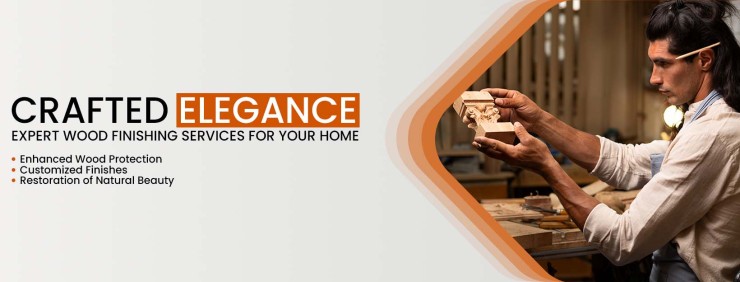Selecting the Right Paint: A Comparison of Plastic Paint and Royale Paint
When it comes to home improvement, selecting the right paint can significantly impact both the aesthetic and durability of your...

When it comes to woodworking, selecting the right finish can be just as crucial as the choice of wood itself. The finish not only protects the wood but also enhances its natural beauty, adding depth and character. With numerous options available, navigating the world of wood finishes can feel overwhelming. This guide will help you understand the different types of wood finishes, their applications, and tips for choosing the right one for your project.
1. Understanding Wood Finishes
Wood finishes can be categorized into two main types: film-forming finishes and penetrating finishes.
• Film-Forming Finishes: These create a protective layer on the surface of the wood. They are ideal for projects that require a durable finish, such as furniture or flooring.
• Penetrating Finishes: These soak into the wood, enhancing its natural grain and providing protection from within. They are often used for items that require a more natural appearance, like wooden countertops or garden furniture.
2. Types of Wood Finishes
Here are some of the most common types of wood finishes available:
• Varnish: A film-forming finish that is durable and resistant to moisture, making it perfect for indoor and outdoor use. Varnish comes in various sheens, from matte to high gloss.
• Lacquer: Quick-drying and easy to apply, lacquer creates a hard finish that can enhance the wood’s natural beauty. However, it can be more challenging to repair than other finishes.
• Polyurethane: Known for its durability, polyurethane is an excellent choice for surfaces that experience heavy use, like tabletops and floors. It is available in both oil-based and water-based formulations.
• Oil Finishes: These penetrate the wood, enhancing its natural color and grain. Popular options include linseed oil and tung oil. Oil finishes require more frequent reapplication but provide a warm, natural look.
• Shellac: A traditional finish made from natural resins, shellac offers a beautiful, warm tone. It dries quickly and can be easily repaired, but it is not as durable as other finishes and may be affected by heat and moisture.
• Wax: A simple and natural finish, wax provides a soft sheen and enhances the wood’s texture. However, it offers minimal protection and may require regular reapplication.
3. Factors to Consider When Choosing a Finish
When selecting a wood finish, consider the following factors:
• Project Type: Different projects have varying durability requirements. For high-traffic items like furniture and flooring, opt for a durable finish like polyurethane or varnish. For decorative items, consider oil or shellac.
• Desired Appearance: Consider the look you want to achieve. Film-forming finishes offer a shiny, polished appearance, while penetrating finishes provide a more natural, matte look.
• Application Method: Some finishes require specific application techniques, such as spraying or brushing. Ensure you are comfortable with the application method for the finish you choose.
• Drying Time: If you need a quick turnaround, consider finishes that dry quickly, like lacquer or water-based polyurethane.
• Environmental Conditions: Consider where the finished piece will be located. For outdoor projects, choose finishes that provide UV protection and resistance to moisture.
4. Tips for Application
• Preparation: Always prepare the wood surface by sanding it smoothly and cleaning off any dust or debris. Proper preparation ensures better adhesion and a smoother finish.
• Test Samples: Before applying the finish to the entire piece, test it on a small, inconspicuous area or scrap wood to see how it looks and reacts with the wood.
• Multiple Coats: For optimal protection and appearance, apply multiple thin coats of finish rather than one thick coat. This helps prevent drips and unevenness.
• Follow Instructions: Always read and follow the manufacturer’s instructions for the specific finish you are using, including recommended application techniques and drying times.
• Ventilation: Ensure good ventilation when applying finishes, especially oil-based and lacquer products, as they can release strong fumes.
5. Maintenance and Care
To prolong the life of your wood finish, regular maintenance is essential. Here are some tips:
• Cleaning: Use a soft, damp cloth to clean finished wood surfaces. Avoid harsh chemicals that can damage the finish.
• Reapplication: Depending on the type of finish and usage, you may need to reapply the finish periodically. Oiled finishes often require more frequent maintenance than varnishes or polyurethanes.
• Protection: Use coasters, placemats, and furniture pads to protect surfaces from scratches, moisture, and heat.
Conclusion
Choosing the right wood finish is crucial for protecting your investment and enhancing the beauty of your woodworking projects. By understanding the different types of finishes and considering factors like project type, desired appearance, and application method, you can make an informed decision that meets your needs. Whether you’re finishing a piece of furniture, cabinetry, or flooring, the right finish will elevate your project and keep it looking beautiful for years to come. Happy finishing!
When it comes to woodworking, selecting the right finish can be just as crucial as the choice of wood itself.
Post Your Comments